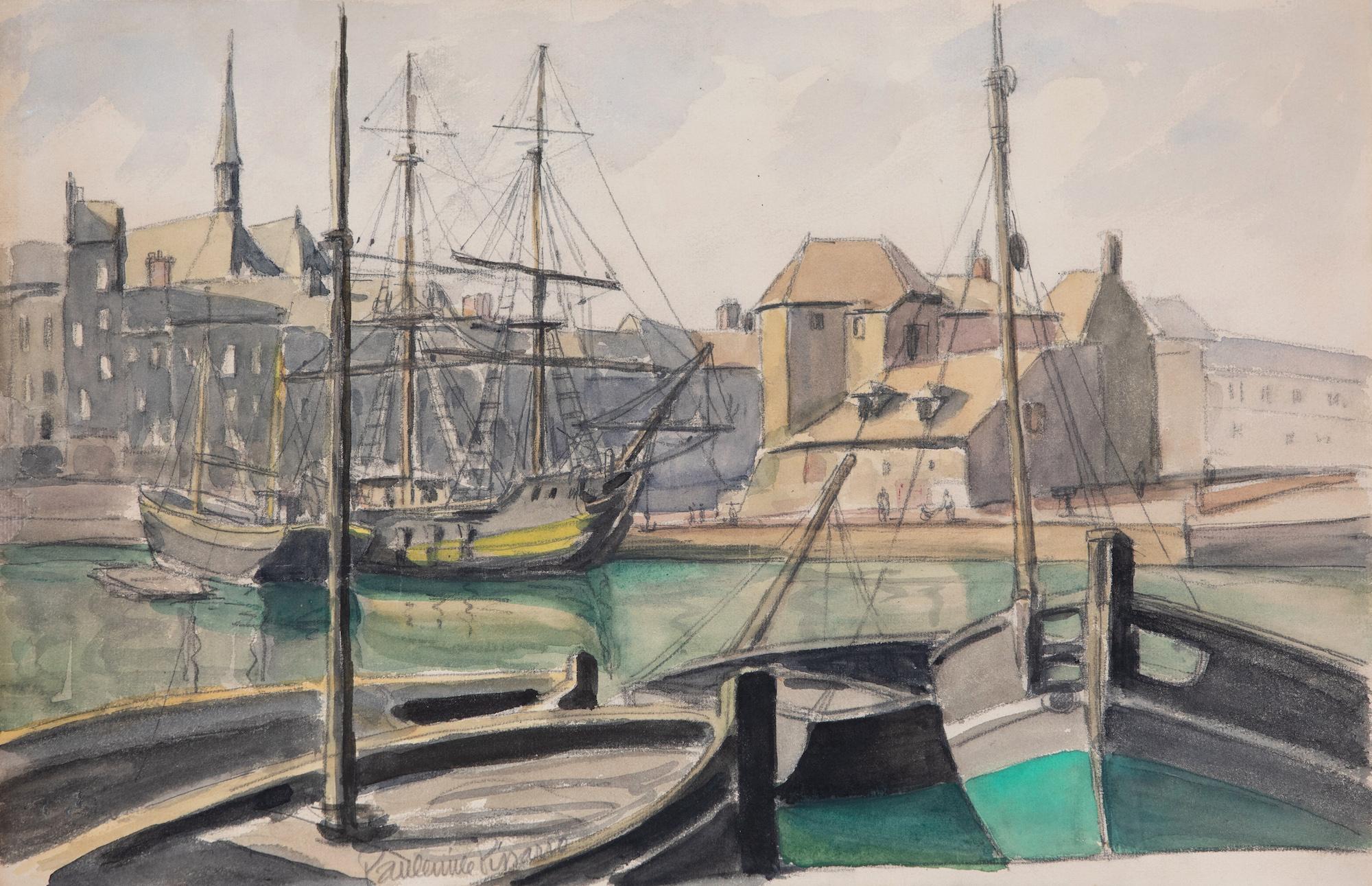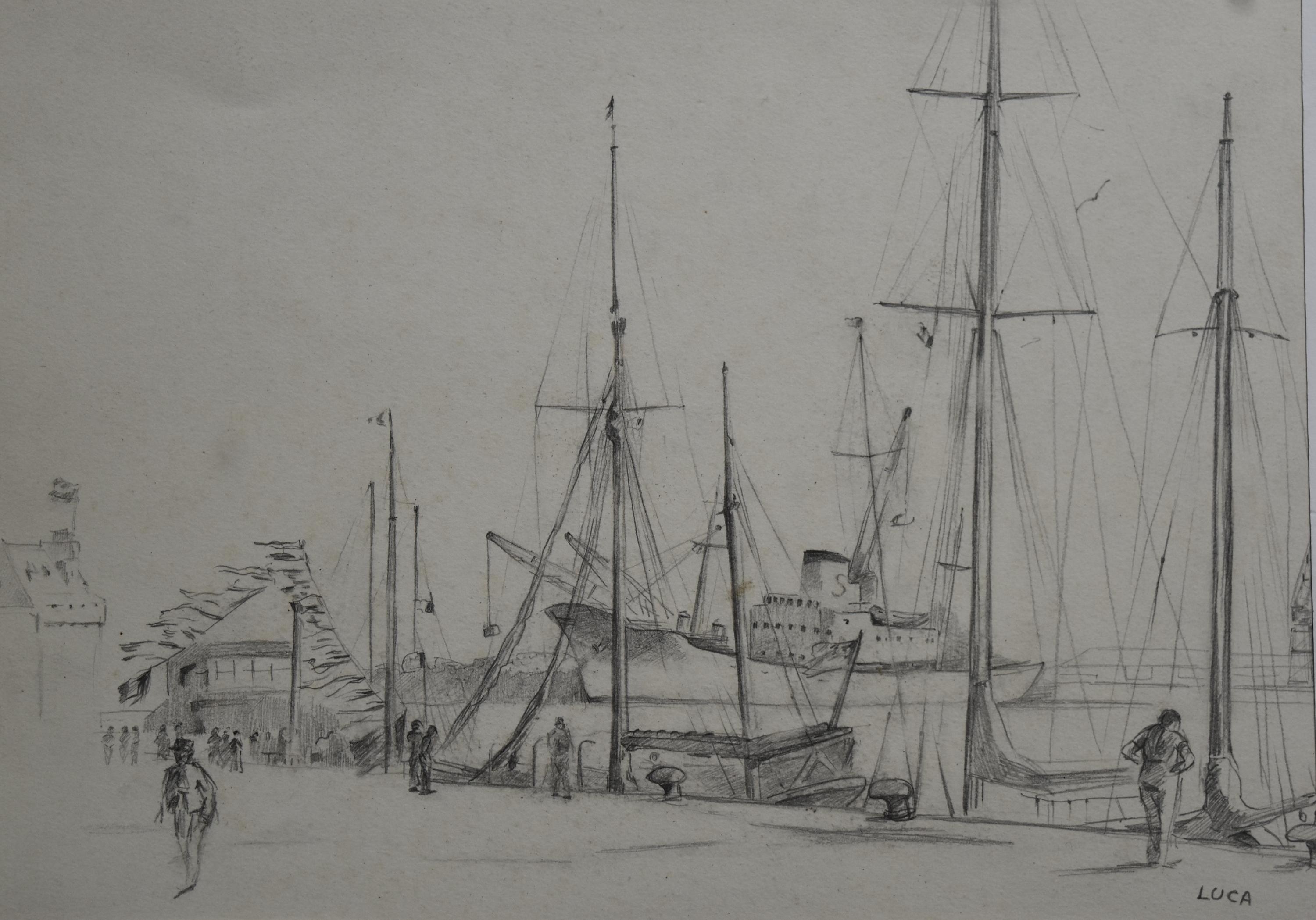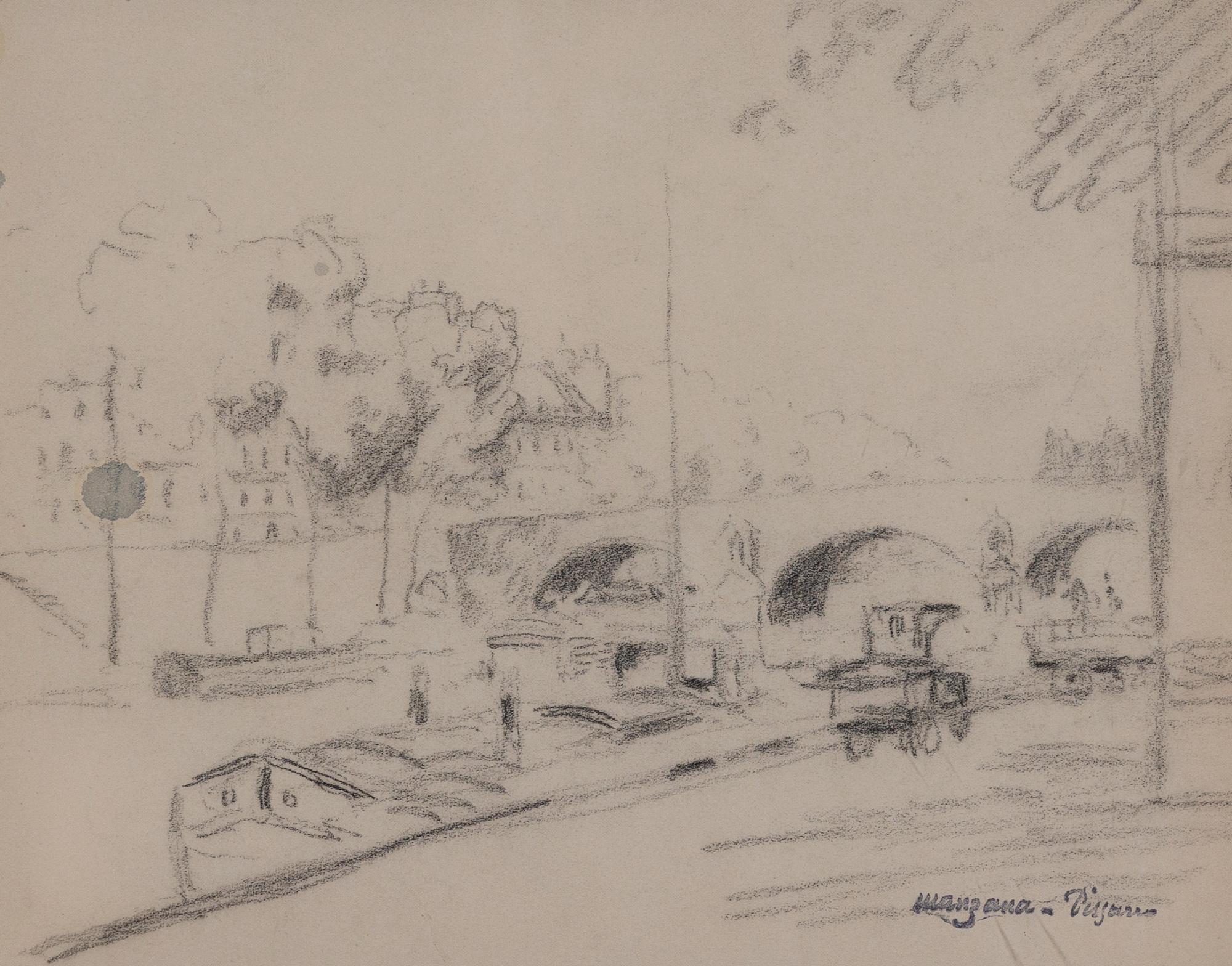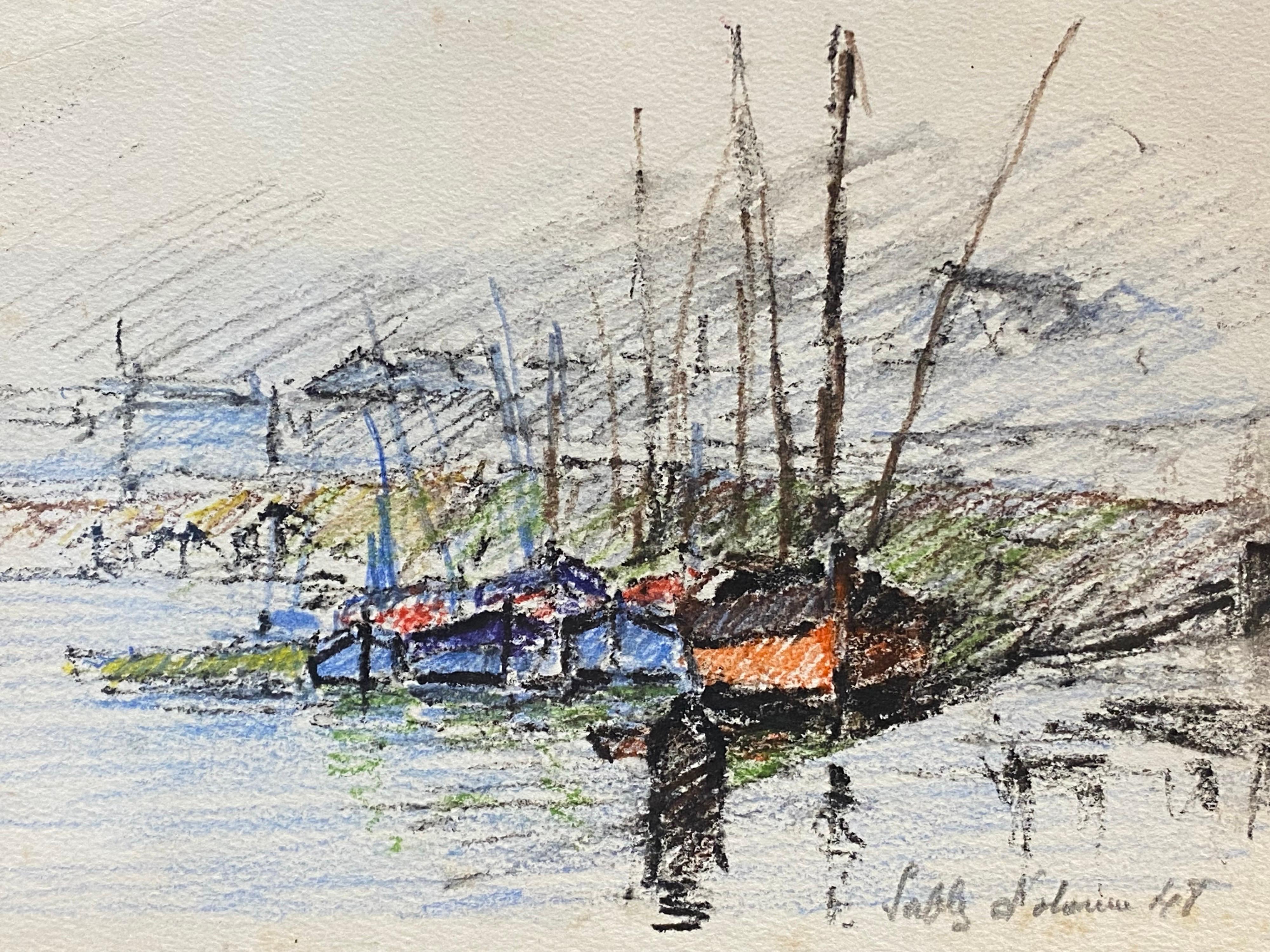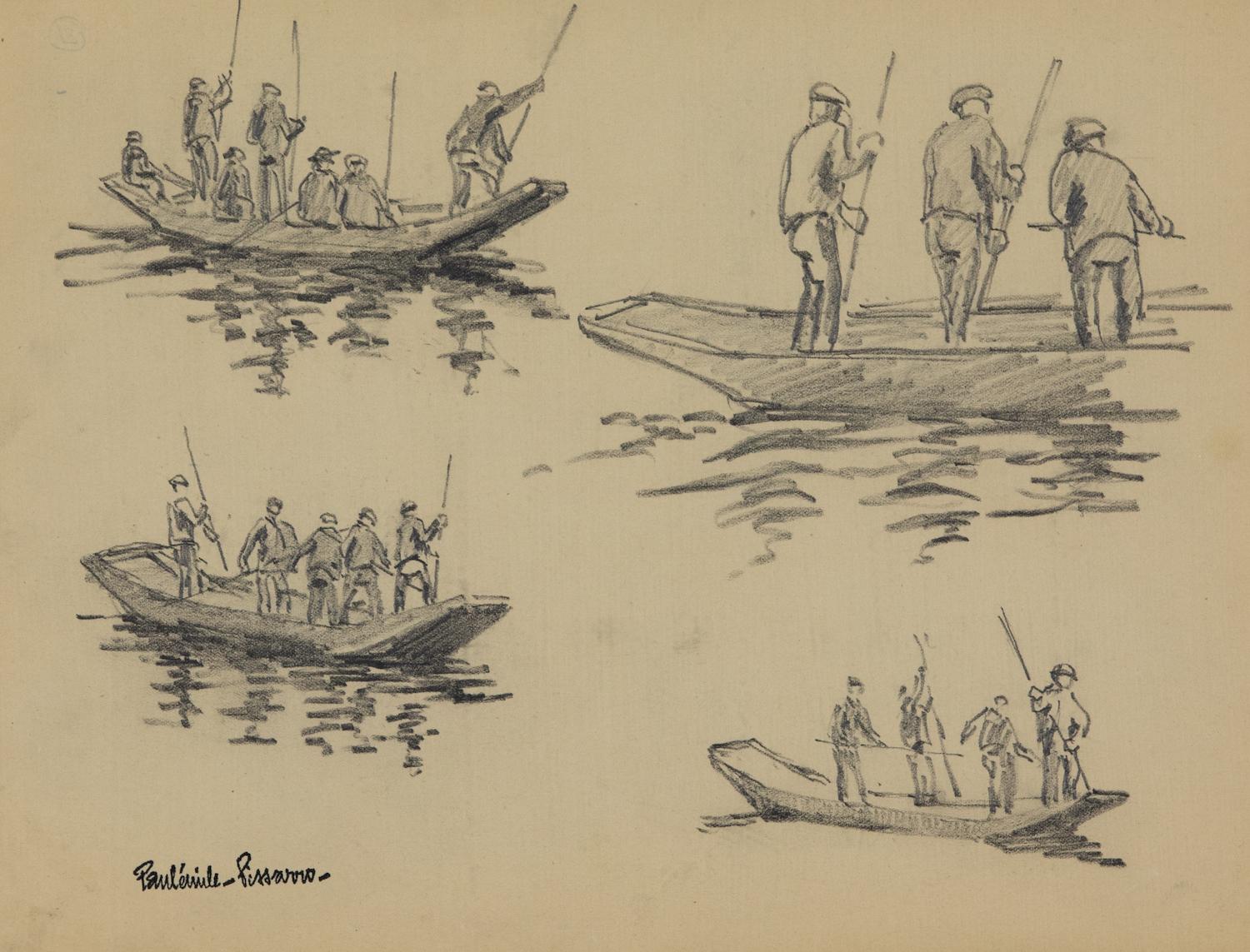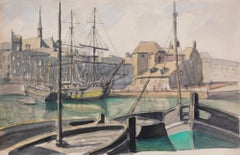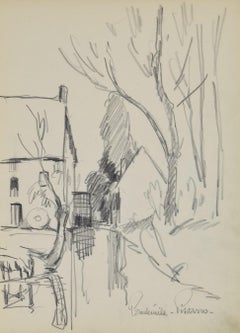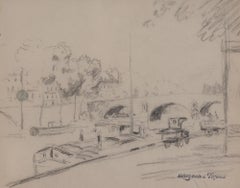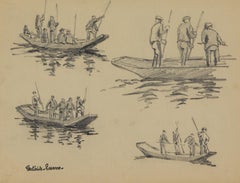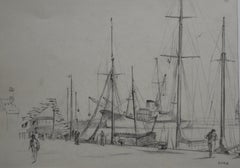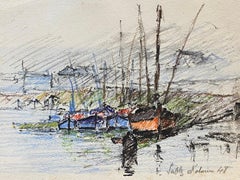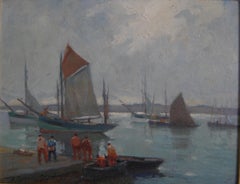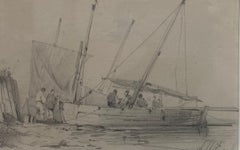Items Similar to Port Scene in Brittany by Georges Manzana Pissarro - Charcoal on Board
Want more images or videos?
Request additional images or videos from the seller
1 of 10
Georges Manzana PissarroPort Scene in Brittany by Georges Manzana Pissarro - Charcoal on Boardcirca 1930
circa 1930
$5,000
£3,795.91
€4,341.72
CA$6,985.73
A$7,769.65
CHF 4,057.07
MX$94,548.39
NOK 51,814.98
SEK 48,593.31
DKK 32,403.90
Shipping
Retrieving quote...The 1stDibs Promise:
Authenticity Guarantee,
Money-Back Guarantee,
24-Hour Cancellation
About the Item
Port Scene in Brittany by Georges Manzana Pissarro (1871 - 1961)
Charcoal on artist's board
50 x 66 cm (19 ³/₄ x 26 inches)
Signed on the reverse
This work is accompanied by a certificate of authenticity from Lélia Pissarro.
Artist biography
Like all second-generation Pissarro artists, Georges Henri ‘Manzana’ Pissarro initially worked under a pseudonym. Born in 1871, Manzana was the third of Camille Pissarro’s seven children, adopting the name ‘Manzana’ in 1894 after the maiden name of his maternal grandmother. It was not until around 1910, to honour his deceased father, that he employed his family name when signing his work.
Manzana studied with his father from an early age and spent his formative years surrounded by the distinguished artists associated with the Impressionist movement – Claude Monet, Paul Cézanne, and Paul Gauguin – who frequented the Pissarro home in Éragny. At his father's side he learnt not only to handle brush and pencil but also to observe nature and its changing qualities.
Subjected to rich and diverse influences, Manzana became a prolific and versatile artist, working with oil, pastel and watercolour as well as etchings, lithography and stencils. As a young man he adopted his father's purely Impressionist style and produced a series of landscapes around Éragny. He exhibited Impressionist works at the Salon d'Automne and the Salon des Indépendants, as well as Durand Ruel and Druet galleries in Paris in the early 1900s.
In 1906 his work began to evolve. Inspired by Dr Mardus’ French translation of ‘A Thousand and One Nights’, Manzana embarked on a grand project to publish his own illustrated version of these magical tales. This pulled Manzana into the umbrella of the decorative arts movement where he flourished creating tapestries, glassware, furniture, ceramics and metal work, all inspired by Orientalism and often incorporating gold, silver and copper paint. In 1907 he had his first exhibition of decorative works at Vollard but it was the 1914 exhibition at the Musée des Arts Décoratifs in Paris which dramatically boosted his career. Here he exhibited 311 works including tapestries, carpets, furniture, glassware, decorative paintings, etchings and lithographs.
The subsequent years were filled with bright ideas, gilded costumes and a glittering lifestyle as Manzana navigated the 20s and 30s between Les Andelys and Paris, spending many summers in Brittany. These culminated in a series of colourful yet delicate new works which Manzana exhibited prolifically. When war broke out in 1939 Manzana moved with his family to Casablanca, where he remained until 1947. Manzana was married and widowed three times. The last years of his life were spent in Menton with his son Félix who was also an accomplished artist. There Manzana returned to the Impressionist tradition of his early years, painting the serene landscapes that surrounded him.
- Creator:Georges Manzana Pissarro (1871 - 1961, French)
- Creation Year:circa 1930
- Dimensions:Height: 19.69 in (50 cm)Width: 25.99 in (66 cm)
- Medium:
- Movement & Style:
- Period:
- Condition:
- Gallery Location:London, GB
- Reference Number:1stDibs: LU261213471932
Georges Manzana Pissarro
Like all second-generation Pissarro artists, Georges Henri ‘Manzana’ Pissarro initially worked under a pseudonym. Born in 1871, Manzana was the third of Camille Pissarro’s seven children, adopting the name ‘Manzana’ in 1894 after the maiden name of his maternal grandmother. It was not until around 1910, to honour his deceased father, that he employed his family name when signing his work. Manzana studied with his father from an early age and spent his formative years surrounded by the distinguished artists associated with the Impressionist movement – Claude Monet, Paul Cézanne, and Paul Gauguin – who frequented the Pissarro home in Éragny. At his father's side he learnt not only to handle brush and pencil but also to observe nature and its changing qualities. Subjected to rich and diverse influences, Manzana became a prolific and versatile artist, working with oil, pastel and watercolour as well as etchings, lithography and stencils. As a young man he adopted his father's purely Impressionist style and produced a series of landscapes around Éragny. He exhibited Impressionist works at the Salon d'Automne and the Salon des Indépendants, as well as Durand Ruel and Druet galleries in Paris in the early 1900s. In 1906 his work began to evolve. Inspired by Dr Mardus’ French translation of ‘A Thousand and One Nights’, Manzana embarked on a grand project to publish his own illustrated version of these magical tales. This pulled Manzana into the umbrella of the decorative arts movement where he flourished creating tapestries, glassware, furniture, ceramics and metal work, all inspired by Orientalism and often incorporating gold, silver and copper paint. In 1907 he had his first exhibition of decorative works at Vollard but it was the 1914 exhibition at the Musée des Arts Décoratifs in Paris which dramatically boosted his career. Here he exhibited 311 works including tapestries, carpets, furniture, glassware, decorative paintings, etchings and lithographs. The subsequent years were filled with bright ideas, gilded costumes and a glittering lifestyle as Manzana navigated the 20s and 30s between Les Andelys and Paris, spending many summers in Brittany. These culminated in a series of colourful yet delicate new works which Manzana exhibited prolifically. When war broke out in 1939 Manzana moved with his family to Casablanca, where he remained until 1947. Manzana was married and widowed three times. The last years of his life were spent in Menton with his son Félix who was also an accomplished artist. There Manzana returned to the Impressionist tradition of his early years, painting the serene landscapes that surrounded him.
About the Seller
5.0
Recognized Seller
These prestigious sellers are industry leaders and represent the highest echelon for item quality and design.
Established in 1964
1stDibs seller since 2015
103 sales on 1stDibs
Typical response time: 7 hours
Associations
Society Of London Art Dealers
- ShippingRetrieving quote...Shipping from: London, United Kingdom
- Return Policy
Authenticity Guarantee
In the unlikely event there’s an issue with an item’s authenticity, contact us within 1 year for a full refund. DetailsMoney-Back Guarantee
If your item is not as described, is damaged in transit, or does not arrive, contact us within 7 days for a full refund. Details24-Hour Cancellation
You have a 24-hour grace period in which to reconsider your purchase, with no questions asked.Vetted Professional Sellers
Our world-class sellers must adhere to strict standards for service and quality, maintaining the integrity of our listings.Price-Match Guarantee
If you find that a seller listed the same item for a lower price elsewhere, we’ll match it.Trusted Global Delivery
Our best-in-class carrier network provides specialized shipping options worldwide, including custom delivery.More From This Seller
View AllPort de Honfleur by Paulémile Pissarro - Watercolour
By Paul Emile Pissarro
Located in London, GB
Port de Honfleur by Paulémile Pissarro (1884-1972)
Watercolour and crayon on paper
31.5 x 47.7 cm (12 ³/₈ x 18 ³/₄ inches)
Signed lower left, Paulémile Pissarro
Executed circa 1925
...
Category
1920s Figurative Drawings and Watercolors
Materials
Paper, Crayon, Watercolor
Village au bord de l'Eau, Graphite on Paper by Paulémile Pissarro, 1934
Located in London, GB
SOLD UNFRAMED
Village au bord d l'Eau by Paulémile Pissarro (1884-1972)
Graphite on paper
32 x 23.5 cm (12 ⁵/₈ x 9 ¹/₄ inches)
Signed lower right, Paulémile-Pissarro-
Executed circ...
Category
1930s Post-Impressionist Drawings and Watercolor Paintings
Materials
Paper, Graphite
La Seine à Paris by Georges Manzana Pissarro - Work on Paper, Paris scene
By Georges Henri Manzana Pissarro
Located in London, GB
La Seine à Paris by Georges Manzana Pissarro (1871-1961)
Pencil on paper
22.5 x 28.3 cm (8 ⁷/₈ x 11 ¹/₈ inches)
Stamped lower right, Manzana-Pissarro
Executed circa 1930
This work i...
Category
1930s Impressionist Figurative Drawings and Watercolors
Materials
Paper, Pencil
Pêcheurs by Paulémile Pissarro - Drawing of fishermen
By Paul Emile Pissarro
Located in London, GB
Pêcheurs by Paulémile Pissarro (1884-1972)
Pencil on paper
23.1cm x 30.9
Stamped lower left, Paulémile-Pissarro-
This work is accompanied by a certificate of authenticity by Lélia P...
Category
Mid-20th Century Post-Impressionist Figurative Drawings and Watercolors
Materials
Paper, Pencil
Paysage en Normandie by Georges Manzana Pissarro - Charcoal landscape
By Georges Henri Manzana Pissarro
Located in London, GB
Paysage en Normandie by Georges Manzana Pissarro (1871-1961)
Charcoal on paper
32 x 39 cm (12 ⅝ x 15 ⅜ inches)
Stamped lower right, Manzana Pissarro
Executed circa 1930
Artist biogr...
Category
1930s Post-Impressionist Landscape Drawings and Watercolors
Materials
Paper, Charcoal
Hommes Pagayant, Work on paper by Paulémile Pissarro - Drawing
Located in London, GB
SOLD UNFRAMED
Hommes Pagayant, Painting by Paulémile Pissarro
Graphite and charcoal on paper
27 x 20.3 cm (10 ⁵/₈ x 8 inches)
Signed lower right, Paulémile-Pissarro-
Provenance
Est...
Category
1930s Post-Impressionist Drawings and Watercolor Paintings
Materials
Paper, Charcoal, Graphite
You May Also Like
Pierre Lucas (1913 1978) Mastings In Saint Malo, 1959, Drawing
Located in Paris, FR
Pierre Robert Lucas (1913-1978)
Mastings, an animated vew of the Port of Saint Malo, 1959,
pencil drawing
signed "Luca" on the lower right
25.5 x 34 cm
titled and dated on the r...
Category
1950s Post-Impressionist Landscape Drawings and Watercolors
Materials
Carbon Pencil
$158 Sale Price
43% Off
Breton Harbour Boats, Camille Meriot French Signed Impressionist Crayon Drawing
By Camille Meriot
Located in Cirencester, Gloucestershire
"Breton Harbour"
by Camille Meriot (French 1887-1975)
signed and dated 48'
crayon drawing on paper
paper : 5 x 7.5 inches
Fine original French Impressionist painting by the well ...
Category
Mid-20th Century Impressionist Landscape Paintings
Materials
Crayon
French Post Impressionist Breton school Oil Painting of Harbour, Douarnenez
By Henry Maurice CAHOURS
Located in ludlow, GB
French Post Impressionist Oil Painting of Breton Fishermen and Boats in the Harbour at Douarnenez.
A perfect study in post impressionism both in subject matter and technique. Cahour...
Category
Early 20th Century Post-Impressionist Landscape Paintings
Materials
Oil
French school of the nineteenth century, LW (?) Harbor scene, drawing signed
Located in Paris, FR
French school of the nineteenth century, LW (?)
Harbor scene, animation around a skiff
Pencil on paper Signed LW (?) Bottom right
15 x 21 cm
Framed : 27 x 34.5 cm
This very fine ...
Category
1840s Romantic Landscape Drawings and Watercolors
Materials
Carbon Pencil
$474 Sale Price
20% Off
Brittany Fishing Boats in Harbour, French Signed Impressionist Crayon Drawing
By Camille Meriot
Located in Cirencester, Gloucestershire
"The Harbour"
by Camille Meriot (French 1887-1975)
signed and dated 64'
crayon drawing on paper
paper : 6.5 x 9 inches
Fine original French Impressionist painting by the well lis...
Category
Mid-20th Century Impressionist Landscape Paintings
Materials
Crayon
Vue du Port au Chemin de Fer à Honfleur
By Johan Barthold Jongkind
Located in Roma, IT
Signed on plate.
Plate: 267
Image Dimensions : 24 x 34 cm
This artwork is shipped from Italy. Under existing legislation, any artwork in Italy created over 70 years ago by an arti...
Category
1860s Impressionist Landscape Prints
Materials
Etching
More Ways To Browse
Vintage Drawing Ideas
George Post Paintings
Vintage In Out Board
Charcoal Drawing Paris
Cezanne Drawings
Lithograph On Board
Monet Drawings
French Brittany Furniture
George Post Watercolor Paintings
George Post Watercolor
Charcoal Drawing Of Man
Charcoal Gold Frame
Casablanca Vintage
Monet Etching
Maiden Home
Claude Monet Etching
Watercolor Death
Architectural Drawings And Watercolours
